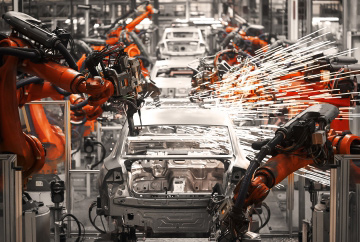As per the 16th annual KPMG global semiconductor industry outlook, which surveyed top global semiconductor executives, 50% of industry leaders stated that COVID-19 had accelerated digital transformation of the semiconductor industry. Despite this acceleration, the adoption of digital initiatives lags the tech sector overall (89%) and other industries (81%).
According to a McKinsey study, the application of AI/ML use cases delivers the most value—about 40% in optimizing semiconductor manufacturing efficiencies.
These use cases significantly improve the throughput of a Fabrication Plant (Fab). With consistent application, a Fab can expect cost-cutting to the range of 17%.
AI in Semiconductor Industry: Use Cases
The applications of AI span across the length and breadth of the semiconductor industry. Here's a look at the growing expanse of AI in the semiconductor industry:
Chip Development and Design
The procession time for chip production is one of the key challenges in the semiconductor supply chain. During this time, up to 30% of production costs are lost to testing and yield losses. Hence, embedding AI applications into the production cycle allows companies to systematically analyze losses at every production stage to assist manufacturers in optimizing operations.
Working with next-generation semiconductor materials, this ability to assess losses becomes even more valuable as these materials tend to be more expensive (and volatile) than traditional silicon. If recent news is anything to go by, we have global companies joining the AI bandwagon in AI, including Google, Nvidia, and now Samsung. According to Wired, Samsung is using Synopsys AI software to design its Exynos chips, which are used in smartphones, including its own branded handsets, as well as other gadgets.
Visual Inspection of Wafers
Visual inspection of wafers helps ensure quality by detecting defects early in the front-end and back-end production process. As per McKinsey, with the help of advancements in deep learning technologies for computer vision, wafer-inspection systems are enhanced to automatically identify and classify defects at an accuracy rate that is on-par or better than human inspections.
This approach helps companies gain early insights on potential process or tool deviations, allowing them to detect problems earlier and improve yields, all while reducing costs.
Inventory Optimization
According to the 2020 McKinsey Global Survey on AI, 50% of businesses have adopted AI in at least one business function.
Findings also point out that the product or service-development and service-operations functions have the highest rate of AI adoption.
The largest shares of businesses have reported revenue increases for inventory and parts optimization, pricing and promotion, customer-service analytics, and sales and demand forecasting within these functions. AI enables physical tasks such as relocating and tracking items or more complicated processes requiring advanced insights for error-free planning or demand forecast.
How is AI Transforming the Semiconductor Industry: Top Use Cases and Benefits



